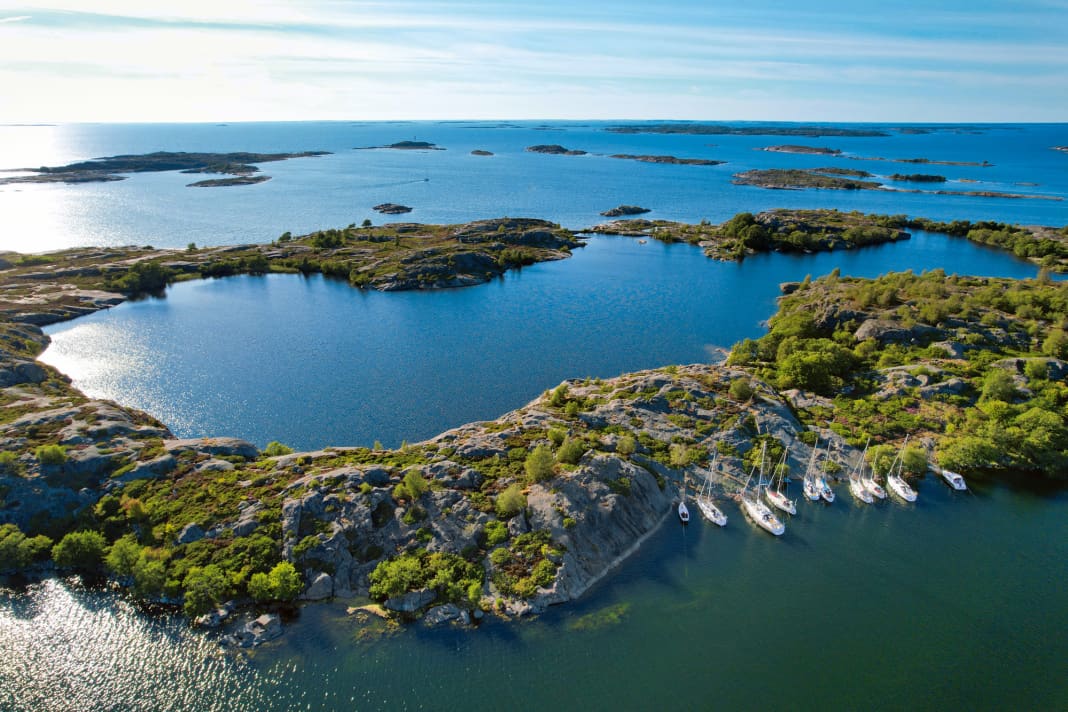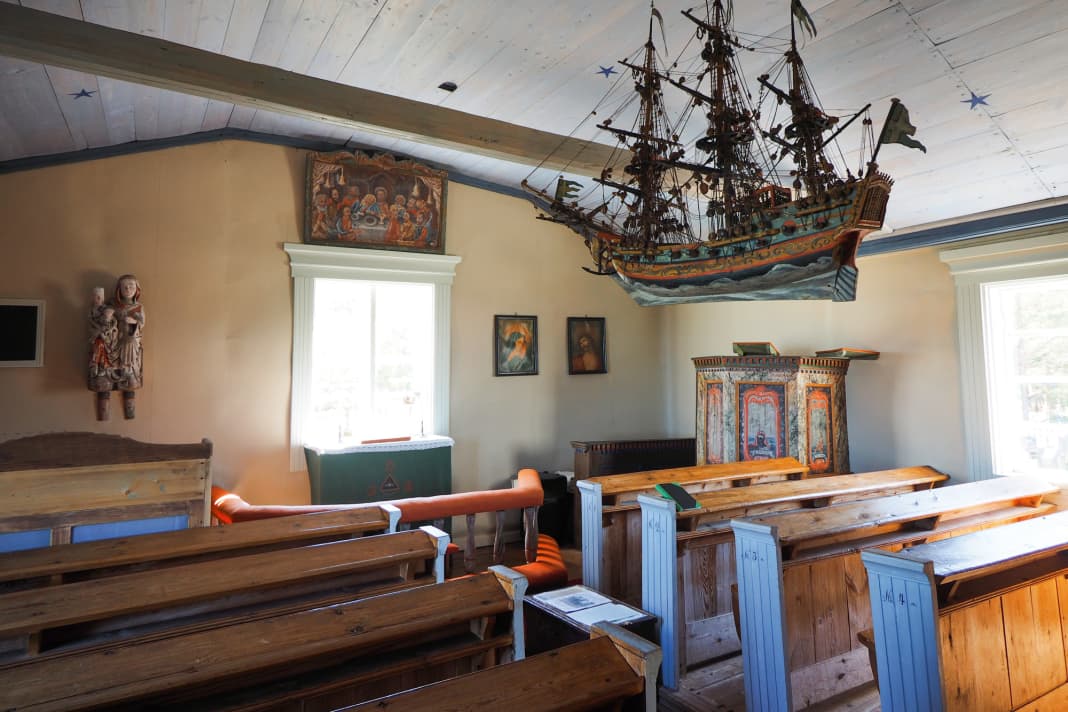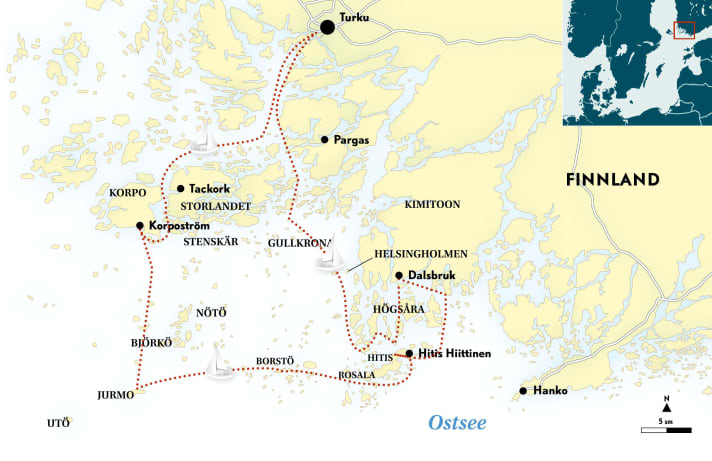





In this article:
This cruise begins before you have even set foot on Finnish soil. From the sun deck of the ferry to Helsinki, on which we travelled, the view sweeps over the archipelago off the coast for the first time. It's as if the ship is travelling through the middle of a Japanese rock garden, it looks so finely arranged. A few sailing boats are scattered in between. This creates anticipation for the upcoming trip in the Turku archipelago. But also a good dose of respect. Nowhere in the world is the density of islands higher than here in Finland. According to Turku University, there are an impressive 44,225 large, small and tiny islets scattered across the archipelago. And that's not counting all the numinous shallows lurking just below the water's surface.
"So what - no problem! Just stick to the fairways," advises Hannu Pahtu a few hours later. He is the boss of Midnightsunsailing and in Dalsbruk he gives us the use of his largest boat in the fleet to explore the area: a Beneteau 50, which is not only 15 metres long, but also has a keel depth of 2.40 metres. To us, that seems a little oversized for this area. But Pahtu shrugs his shoulders: "Sorry - corona!" he says. In order to survive, he has had to sell three smaller ships and the others are all on their way.
Finally, he tells us where the most beautiful places are. He writes down the names of seven islands and harbours on a piece of paper for us to visit. The Åland Islands, which most Baltic sailors know at least from hearsay, are not on the list. He thinks it would be overambitious to sail to them with only one charter week. We would miss out on a lot of other things. "Have a look at Turku instead. It's a beautiful, young city," he says. There's also a street art festival this week.
The art of damage-free skerry navigation in Finland
So let's go! But before we start thinking about our first destination, we need to familiarise ourselves with the art of navigating the archipelago without causing damage. Get up close and personal with the area - literally. And that nice and slowly, i.e. initially only with a large genoa. Jibing into the wind with a full sail, keeping an eye out for buoys and then correctly assigning them all seems a bit much for the first day of sailing. Especially as the two light sailors on board - my two boys - still need a refresher course in navigation and cardinal marks.
More cloth is not necessary. The ship runs effortlessly at seven knots without a main. Almost five knots too many for my liking, if you want to get your bearings among the many tonnes. This is urgently needed. There are plenty of natural stumbling blocks to the left and right of the fairway.
Gradually, the tension subsides and you can enjoy the leisurely glide over the glistening waters of the Baltic Sea. The surroundings could hardly be more Scandinavian: skerries wherever you look. Sometimes more, sometimes less wooded. In between, calm water. The only waves come from other boats coming towards you. Plus plenty of sunshine and a pleasant 3 to 4 Beaufort from the south-east. That's as good as it gets.
On day two, we also set the main. We have worked our way westwards through the archipelago to the southernmost main route. The fairway becomes wide enough for us to cross until our arms ache from the constant tightening of the large genoa. It's good to have two teenagers on board who discover the winches as fitness equipment and outdo each other. Until their arms burn.
There is always a beautiful archipelago to be found
In addition to buoys and shallows, you also need to keep an eye on oncoming traffic. The summer holidays in Finland are drawing to a close and many sailing boats are heading home. It's a bit like being on the motorway to Helsinki. People are eager to say hello. Without exception. The boys ask where we're actually going. Answer: Suggest something! Theoretically, you could take the exit almost anywhere on the port or starboard side. There's always a skerry to tie up to. Although many of the islands are privately owned. Only mooring at private jetties, however deserted and tempting they may look, is taboo. As long as you don't moor within sight of the sauna, everyman's right applies. In other words, there is enough freedom for everyone.
Thanks to everyman's right, you can even moor on private islands. But keep your distance from holiday homes, jetties and saunas
We finally decide to make a pit stop in Borstö. A quick refuelling and mooring in the guest harbour with a stern buoy in a Bullerbü atmosphere. We don't sail further west to Jurmo until the evening. There is also a guest harbour there and even a small shop. Unfortunately, the water depths at the jetty turn out to be too shallow for our boat. A man with heavy soundproof headphones indicates that we should go alongside the pier for the ferry. He looks like a harbour worker or helicopter pilot.
After accepting our lines and handing them back on board, he introduces himself as Wilhelm Helsingius and explains what the ear protection is all about. He used to be a drummer and used to beat his ears to death. Today he suffers from tinnitus and is very sensitive to noise. "But that's just one reason why I spend the summer out here on Jurmo on my boat. I like it here, the people, the life," says Helsingius. He helps out a little where he can. He also gives us a few tips on what we should head for next.
Björkö as a highlight in the Turku archipelago
Björkö is at the top of the list. With three exclamation marks. There is a natural harbour there. And on the skerry, surprise surprise, a freshwater lake. The only one in the whole archipelago! But then comes the damper when the question of our draught comes up. An incredulous, almost pitying look. "2.40 metres, my goodness, that could be tight," says Helsingius.
So be it. Let's take a look at Jurmo first. The island is different. It has a barren beauty and a tragic history. It was once home to beach pirates who lured Swedish merchant ships to their doom and plundered them. The king soon got fed up with this. He sent soldiers and they made short work of them. The inhabitants of Jurmo were murdered and the island completely cleared. The silence here takes on a different tone in the evening.
The next day, Wilhelm comes to the boat with good news. He has phoned the new owners of Björkö for us. They say that with our draught, we should just keep further west in the entrance to the bay, close to the shore. Contrary to the nautical chart, it would be up to three metres deep there. Let's get there! The stage is short, but once we've arrived, the boys can take a long swim in the lake on the island without worrying about annoying jellyfish. Surrounded by the Baltic Sea, it is framed by a magical archipelago landscape. Incredibly beautiful.
"Up to 100 boats are moored here in summer," Santeri, who owns the island together with his girlfriend Tiia, tells us. The two of them run a café on Björkö. The young couple bought the old farm on the island, including the lake, a few years ago. It has nothing to do with the drop-out lifestyle. "We only open the café during the season. Next week we're flying to Seoul to study," says Santeri. He wants to become an engineer, Tiia is studying international business. They offer homemade cakes in their café. We try some rhubarb tarts, they are delicious! The recipe, the two reveal, is 400 years old, as old as the farm dates back.
Turku as an urban change from the solitude of the archipelago
After three days of sailing around the archipelago, it becomes clear that heading for the Åland Islands would indeed be difficult. The wind is still blowing strongly from the south-west, with gusts of up to 6 Beaufort. Why beat against it when there is a worthwhile destination in every direction! Korpoström and Högsåra, for example. Or Utö, one of the outermost islands in the archipelago. After a brief consultation with the crew, the decision is made in favour of Turku. A bit of culture after so much nature. A change like this undoubtedly adds to the appeal of the area.
The journey to the city is a pleasure. The jibes are perfect and there are no waves to disturb our speedy journey. It's a real pleasure. We sail slalom around the archipelago at seven to eight knots, unreefed. Towards evening we moor in Korpoström. The marina is very popular with the locals. Firstly because of the restaurant and secondly because of the changing exhibitions and cultural performances. On this particular day, a vernissage is being organised on the subject of "Traditional boatbuilding in the archipelago". In passing, we learn that the Night of the Arts is taking place in Turku tomorrow. All the more reason to savour the space breeze.
Finland as a sailing paradise
The closer you get to Turku, the more numerous the sailing ships and the more dignified the holiday homes on the shores. You almost feel like you're in the Hamptons instead of Finland. We sail almost all the way up into the River Aura. On the port side, we pass the Forum Marinum, a fleet of historic ships. To starboard, modern house facades. Finally, ahead, an ancient chain ferry rattles across the river at a snail's pace. Just ahead is the guest marina, which has space for us even without a reservation. And a cheap one at that: 35 euros for 15 metres of boat, including electricity and sauna! We don't need to show any ID or boat papers. Less bureaucracy is hardly possible. And no more hospitality either. Finland is a country for sailors.
As promised, Turku is young and lively, almost a little Mediterranean. The crowds stroll along the river or ride electric scooters. The Night of the Arts mainly refers to street artists. The performances are rather poor, but that's not a problem. Turku itself is attraction enough.
In many places, the fairways between the skerries are wide enough to be able to sail upwind in windy conditions
The next day, the wind has calmed down. We cruise a little way into the archipelago again, make way for the ferries and try to reach the wooden jetty in Seili, but fail because of the depth of the water in the beautiful, reedy bay. Unfortunately, there is no dinghy on board. This is followed by a short odyssey in search of a place to spend the night, taking into account the privacy of the holiday home fins. There are plenty of them in the vicinity of Turku. The next gem around every corner. And each time with a house and jetty. You can only groan and sigh. So idyllic, so beautiful and yet so useless for a sailor that you feel momentarily marginalised.
Eventually, however, we find the perfect skerry for the night. The water is deep enough right up to the rock so that we can get out over the bow. We quickly put the mooring lines ashore and deploy the stern anchor, and we are already sheltered from the wind off "our" little island. Illuminated by the full moon. Awakened by the sun. Kissed by the gods. The world has rarely been more beautiful and peaceful.
Five tips for cruising in Finland






Area information Finland/Turku

Journey
Take the Finnlines ferry from Travemünde to Helsinki, ideally with your own car. The crossing takes a relaxed 30 hours. The four-bed inside cabin costs from 428 euros per passage for four people including car in the low season, the outside cabin 493 euros. Those who also book the return journey receive a 20 per cent return discount.
Wind & Weather
The weather on the islands is generally somewhat warmer than on the Finnish mainland. In summer, temperatures range between 15 and 25 degrees Celsius. Winds often blow from the south-west to west. In early summer, the large temperature difference between the cold water and the already warmed air creates a stronger sea breeze. There is sometimes a short, steep wave, especially between the outer skerries. The first autumn storms can be expected at the end of September.
Navigation & Seamanship
The area is challenging. Stones, rocks and skerries not only look very beautiful everywhere, but also very similar. Probably the most important rule is to know exactly where you are at all times. Paper charts should therefore always be kept to hand in the cockpit and constantly checked against reality. Red and green buoys are rarely found, often only in very narrow channels. Unlike in Sweden, cardinal buoys without top marks predominate in the Turku archipelago. You should therefore be very familiar with the colour arrangement of the black and yellow markings. Travelling at night between the stones is generally not recommended.
Literature & Charts
"Küstenhandbuch Ostsee" from Edition Maritim, 69.90 euros; Finnish pleasure craft charts set D via Hansenautic, 58 euros.
Charter
We were travelling with a Beneteau 50 from Midnightsunsailing. The base in Dalsbruk is located south of Turku and west of Helsinki. Depending on the season, the boat costs between 2,600 and 3,900 euros. A Jeanneau SO 33i or a Dufour 325 cost between 1,250 and 2,200 euros per week. Booking under www.midnightsunsailing.fi or via common agencies.

